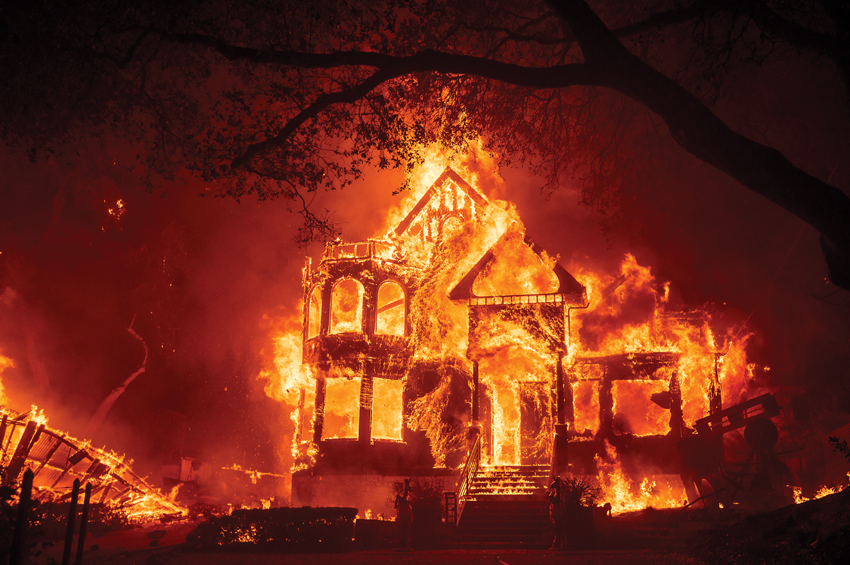Wildfire-Adapted Design
Still, valuable measures involving architecture, construction, landscaping, zoning, land use, and home maintenance can significantly improve protections and resiliency. In 2008, California enacted building code Chapter 7A, one of the few statewide regulations establishing minimum requirements for exterior materials and construction methods in wildfire-prone areas. Applicable to new construction, this legislation focuses on roofs, vents, exterior walls, windows, and porches, offering a menu of noncombustible, ignition-resistant, heat-mitigating, or ember-shielding solutions in each category. Whereas earlier guidelines targeted, almost exclusively, the hazards of wood-shake roof shingles, “we’ve learned that the most likely scenario isn’t a tsunami wave of flame,” says Dicus, “but ignition sparked by windblown embers, and that affects how buildings and their surroundings need to be hardened.” Another major threat, he adds, is high-temperature radiant heat, generating house-to-house blazes.
To keep smoldering embers, or firebrands, from entering attics and crawl spaces, Chapter 7A specifies noncombustible, maximum 1⁄8-inch-mesh vent screens; it also requires comparable protections for building components including roof gutters (where dry leaves could accumulate) and eave soffits. The roof, a particularly vulnerable building component, must be Class A, the highest rating for fire resistance, clad in such materials as metal, concrete or clay tile, or fiberglass-asphalt shingles. Glazing is another key concern, since radiant heat alone can shatter glass and ignite interior combustibles—and any gaps or openings provide access for embers. So code-compliant windows must have tempered or multipane glass.

PHOTOGRAPHY: © ASSOCIATED PRESS
A BED-AND-BREAKFAST in St. Helena was one of hundreds of structures in the Northern California counties of Napa and Sonoma destroyed by this season’s Glass Fire.
Though extreme fire conditions can sometimes overwhelm code requirements, even in Paradise—where glowing-hot pine needles, like lit matches, rained down on the town—such standards may have been essential for withstanding the Camp Fire. An analysis of property records and California Department of Forestry and Fire Protection (CAL Fire) data by the news organization McClatchy found that, in the path of the Camp Fire, nearly 51 percent of the 350 single-family homes built after 2008, when Chapter 7A took effect, escaped damage, while only 18 percent of the 12,100 houses completed earlier endured the fire. Preliminary findings in an ongoing post-fire assessment by Quarles with Yana Valachovic, a forest advisor for Humboldt and Del Norte counties, and colleagues support similar conclusions.
As many experts agree, however, hardening homes against fire must work in tandem with other, equally important, measures: most critically, defensible space. The term refers to a zone immediately around a building, maintained to minimize potentially ember-igniting fuel, as well as flame pathways, by reducing or eliminating vegetation and other combustibles. It also attempts to carve out safe access for firefighters and equipment. California law requires defensible space for most fire-prone areas, with longtime guidelines imposing the most stringent restrictions on Zone 1, the first 30 feet surrounding any structure, and slightly less severe requirements on Zone 2, the band 30 to 100 feet out—but a bill, recently signed into law, adds Zone 0, the first 5 feet, a crucial area for ember-to-house ignition. While the specifics are still in progress, Zone 0 will probably have a prohibition against such combustibles as trees, overarching branches, planting beds, wood mulch, log piles, and flammable fences or trellises. Regulations for the two outer zones include minimum tree spacing (to avoid a continuous canopy) and removal of lower branches (to mitigate ladder fuels).
Planning is also important. Greater distances between structures can reduce house-to-house conflagration, and siting below a hill’s crest, instead of at its peak, can be consequential, as fire tends to race to the top of steep slopes.
But for individual buildings, the existing codes “need to go further,” says Valachovic. She points out that Chapter 7A, for instance, “provides little guidance for post-construction maintenance and doesn’t take a systems approach, integrating the treatment of buildings and their surroundings.” Radiant-heat issues also need more specific attention, she says, since “with homes close together, deployable metal shutters over tempered glass, for example, become more important.”
And Chapter 7A doesn’t deal with the immense challenge of retrofitting pre-2008 construction. While state programs have long provided funding for earthquake-defensive home upgrades, wildfire protections have not received comparable treatment. Local jurisdictions have sometimes offered financial incentives and assistance, but resources are scant. To address such needs, California bill AB-38 passed in 2019, but once Covid overwhelmed the state budget, the funding was cut.
Even for new construction, some communities—including ones previously decimated by wildfire—have bypassed statewide code when it’s recommended but not mandatory. Santa Rosa’s Coffey Park neighborhood, for example, was ravaged by the Tubbs Fire, of 2017, but, before rebuilding, opted out of Chapter 7A, which is discretionary for most urban and suburban areas. Such decisions are often swayed by political pressure to get people back into their houses as quickly as possible (code enforcement requires potentially time-consuming design review) and by limited time frames for fire-insurance payouts. Another factor is sometimes the belief that a megafire’s cause was anomalous—at Coffey Park, embers crossed a six-lane freeway in unusually high winds. (Yet firebrands have vaulted other major highways, as in the Tunnel Fire, which tore through Oakland in 1991, and the Woolsey Fire, of 2018, in Los Angeles and Ventura counties; and in the 2018 Carr Fire, embers traversed the Sacramento River.)









